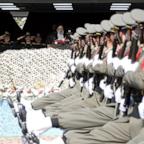Al Qaeda Remarks May Signal Attack
— -- FBI: Al Qaeda Remarks May Signal Attack
W A S H I N G T O N, Oct. 10 — The FBI is warning state and local authorities that recent taped statements by al Qaeda leaders may signal that another attack on the United States has been approved.
The agency said Wednesday, however, that the nationwide alert level remains code yellow — "significant risk" — because officials do not have any specific information detailing where and when an attack may occur. Yellow is the third-highest of five threat levels.
In an audio taped message that aired Sunday on the Arab satellite TV station al-Jazeera, a voice believed to be that of Osama bin Laden refers to al Qaeda "targeting key sectors of the U.S. economy," the FBI noted.
Bin Laden's senior deputy, Ayman al-Zawahir, repeated the threat in another audio taped interview obtained Tuesday.
"The group's leaders have said that they aim to undermine what they see as the backbone of U.S. power, the economy," the FBI said in a statement.
The FBI said its concerns were heightened by comments from al Qaeda detainees who interpreted the taped remarks as a sign of an attack.
White House spokesman Ari Fleischer said earlier in the day information on the Al-Zawahir recording would be shared with law enforcement officers but would not prompt the government to raise the threat level.
The FBI urged law enforcement agencies to take extra precautions to "detect, disrupt, deter, and defend against potential attacks" against the nation, at home and abroad.
—The Associated Press
Recent Attacks Indicate Al Qaeda Danger
W A S H I N G T O N, Oct. 10 — U.S. counterterrorism officials pointed to the shootout in Kuwait and a bombing in the Philippines as potential examples of how a decentralized al Qaeda is operating a year after its base in Afghanistan was destroyed.
While both attacks are suspected of having links to Osama bin Laden's terrorist network, neither was especially sophisticated, with Tuesday's attack in Kuwait amounting to a drive-by shooting and the Philippines strike last week consisting of a nail-packed bomb mounted on a motorcycle.
Attacks directed from al Qaeda's top echelons are generally intended to be spectacular, using lots of explosives, often against multiple targets simultaneously. These small-scale operations may be local operatives acting without direction from the top, officials said.
Although both attacks killed U.S. military personnel, there's no evidence they are connected, a U.S. counterterrorism official said Wednesday, speaking on condition of anonymity. Counterterrorism analysts have expected some kind of action and officials said the small strikes don't eliminate the possibility of a large attack ahead.
In Tuesday's attack, two Kuwaitis in a pickup truck attacked a group of Marines during military exercises on a small island near Kuwait City. Marine Lance Cpl. Antonio J. Sledd, 20, of Hillsborough, Fla., was shot and killed. The attackers then drove to a second location and attacked again before being killed by Marines, the Pentagon said.
State Department spokesman Richard Boucher called the slaying a terrorist act.
On Wednesday, American troops in a Humvee on mainland Kuwait fired on another vehicle when they saw an occupant draw a gun on them, U.S. officials said. Further details were not immediately available.
The Oct. 2 bombing of a market in Zamboanga in the Philippines killed three people, including American Green Beret Sgt. 1st Class Mark Wayne Jackson, 40, who was in the region to train Filipino counterterrorism troops. The attackers are believed to be guerrillas fighting for Abu Sayyaf, an Islamic separatist group that is supported by al Qaeda.
Intelligence officials have said they believe al Qaeda decentralized after the U.S. attacks in Afghanistan. Many of its top leaders are hiding, allowing overseas cells to devise their own attacks, which are often poorly funded and unsophisticated. Leaders are communicating with followers through video and audiotapes, rather than direct contact.




